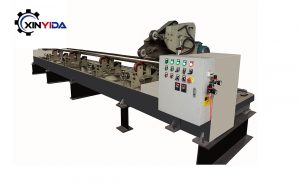When it comes to achieving a high-quality finish on surfaces, the terms “buffing” and “tube polishing” often come up. While both techniques aim to enhance the appearance of materials, they serve different purposes and are utilized in distinct applications. Understanding the differences between buffing and tube polishing machines is crucial for selecting the right method for your needs.
-
Understanding Buffing
Buffing is a finishing process primarily focused on restoring the shine and luster of surfaces. It involves using soft pads made of materials like felt or foam in combination with specialized buffing compounds. The buffing process is less aggressive than polishing, making it ideal for enhancing the gloss of surfaces without significantly altering their texture.
Key Characteristics of Buffing
Minimal Material Removal: Buffing enhances the surface shine without removing much material. This makes it suitable for restoring the appearance of surfaces that are otherwise smooth.
Tools Used: Buffing typically employs rotary buffers or random orbital polishers. These tools spin the pads at high speeds, creating a smooth and shiny finish.
Applications: Commonly found in automotive detailing, furniture restoration, and metal finishing, buffing is ideal for any surface that requires a glossy appearance.
When to Use Buffing
Restoring Luster: Buffing is effective for reviving the shine of dull surfaces, making it perfect for vehicles or furniture that have lost their sheen over time.
Final Touch: After polishing, buffing can provide that final gloss that elevates the overall appearance.
Regular Maintenance: For surfaces that need consistent upkeep, buffing can help maintain their aesthetic appeal.
-
Understanding Tube Polishing Machines
Tube polishing machines are specialized tools designed specifically for polishing cylindrical objects, such as tubes, pipes, and rods. These machines automate the polishing process, ensuring consistent and efficient results across a variety of materials, including metals and plastics.
Key Characteristics of Tube Polishing Machines
Automation: Pipe Polishing Machines are usually automated, significantly increasing productivity and consistency. They can handle high volumes with minimal operator intervention.
Design: These machines typically feature a rotating mechanism that holds the tube in place while polishing wheels or brushes move along the surface, allowing for thorough coverage.
Versatility: Equipped with different types of polishing wheels and abrasives, tube polishing machines can adapt to various materials and desired finishes.
Applications of Tube Polishing Machines
Metal Fabrication: Widely used in metalworking, tube polishing machines are essential for achieving a smooth and shiny finish on stainless steel, aluminum, and other metals.
Manufacturing: In manufacturing settings, these machines prepare parts for assembly and improve their visual quality.
Construction: Tube polishing is common in construction, ensuring that metal components meet both aesthetic and quality standards.
-
Key Differences Between Buffing and Tube Polishing Machines
- Purpose and Application
Buffing is ideal for enhancing the shine of flat or slightly contoured surfaces, while tube polishing is designed specifically for cylindrical objects.
- Equipment Used
Buffing Equipment: Rotary buffers or random orbital polishers, which are versatile for various surfaces.
Tube Polishing Equipment: Specialized machines tailored for cylindrical items, automating the polishing process for efficiency.
- Material Removal
Buffing involves minimal material removal, focusing on shine enhancement.
Tube Polishing may involve more significant material removal, especially for achieving a smooth finish on uneven surfaces.
Choosing the Right Method for Your Needs
When deciding between buffing and tube polishing, consider the type of surface, volume of work, desired finish, and your budget. Buffing is suitable for minor restoration and maintenance, while tube polishing machines are ideal for high-volume production and consistency across cylindrical components.
In summary, buffing and tube polishing serve distinct purposes in achieving a polished finish. Buffing focuses on enhancing shine with minimal material removal, while tube polishing machines provide an automated solution for cylindrical objects, ensuring efficiency and uniformity. By understanding these differences, you can select the appropriate method for your specific needs, ultimately enhancing the quality and appearance of your projects.


